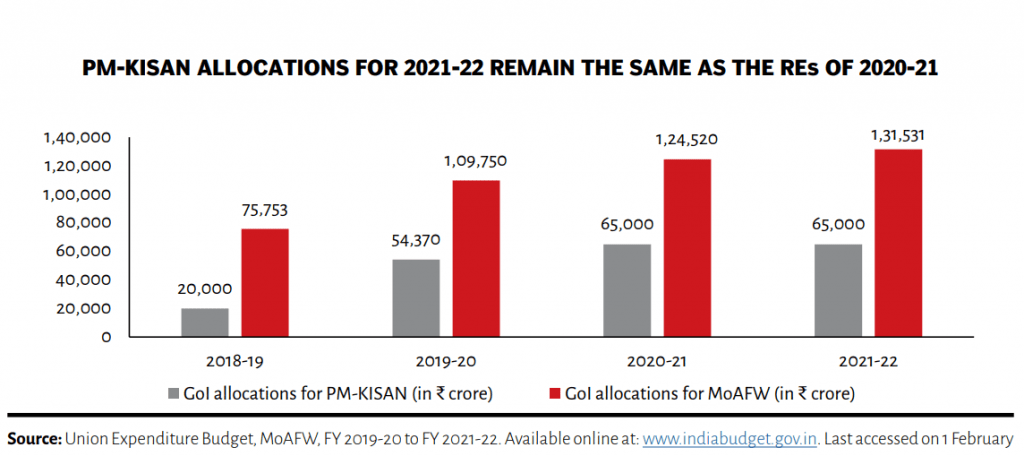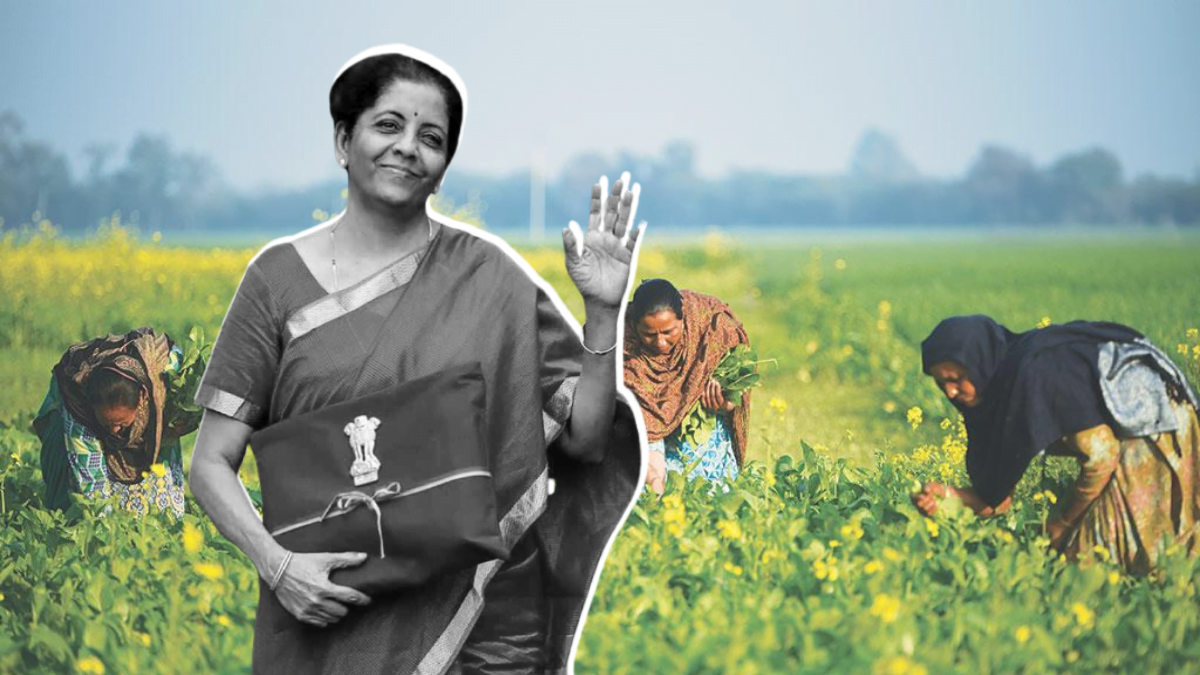With the nation’s coronavirus rush, and arrival of protesting farmers in Delhi, this Financial Year’s Union Budget was presented in the Lok Sabha on Monday under circumstances unparalleled. Balancing low revenues and tackling the current crisis was predictably going to be difficult but the budget has left farmers as well as the general public in deeper despair than before. Standing at 1,31,513 crores, the budget for the Ministry of Agriculture and Farmers’ Welfare (MoAFW) was reduced by 8.5% from the budget estimate of 2020-21.
With continued protests since October, a saturation point seems to have arrived after the Republic Day protests, and the consequent crackdown on protest sites by the government. Farmers’ protest at the Delhi border was sparked after the installation of the infamous Three Farmer’s Acts (The Farmers’ Produce Trade and Commerce (Promotion and Facilitation) Act, The Farmers’ (Empowerment and Protection) Agreement of Price Assurance and Farm Services Act, and The Essential Commodities (Amendment) Act), which threaten to privatise the agriculture sector by revoking the government regulated APMC (Agricultural Produce Marketing Committees) model of Indian farming, exposing farmers to the vulnerabilities of a free market system where profit-oriented big corporations can control the industry.
Over the last few months agriculture experts, farmers, law makers, and the general public alike have echoed the opinion that these Acts will have an adverse impact on the livelihood of the farmers. Budget’s addressal of these concerns were thus highly anticipated.
Additionally, the first burnt of the pandemic was beared by women. Although a gender inclusive approach to the budget was introduced in 2001, it hardly led to the rise of gender equality. No mention of women farmers in the finance minister’s speech this year or any announcement of women-exclusive schemes in the sector is keeping with traditions of ignoring gender-specific issues in any sector.
MSP
Nirmala Sitharaman’s speech which ran 110 minutes long, covered agriculture under the header ‘Inclusive Development for Aspirational India’. She began by outlining the sea of change in the MSP (Minimum Support Price) regime to assure 1.5 times the cost of production. She detailed development in the agriculture sector under the current administration, while employing a comparison to 2013-2014. Highlighting an upwards projection since 2014 owing to MSP regulation, the finance minister mentions the increase in total amount paid to cotton farmers, paddy farmers, pulses farmers, and wheat farmers, with pulses exhibiting a 40 times increase since 2014.

Several farmer unions, however, dismissed any claims of MSP change actually benefiting the farmers. They explain that the reason behind high procurement, especially of paddy and wheat, is much owed to private players who buy surplus in states that do not have an APMC model at a lower price and then sell it in Mandis of other states. Farmers, instead, have been demanding the implementation of recommendations by the Swaminathan Commission to fix the MSP regime.
Many are also of the view that Sitharaman’s speech ignored key issues plaguing the sector currently and engaged in a rather falsely optimistic narration of Indian agriculture’s development over the course of the past decade. “In the agricultural sector, all they have done is highlight some figures,” says Congress leader Kapil Sibal, while commenting on the government’s obvious disdain of recent farmer’s affairs.
APMC and the Mandi System
In addition to MSP, the Farmer Acts threaten the existence of the APMC model, which is one of the main reasons behind the current protests. But despite mentioning an allotment to APMC infrastructure under the Agriculture Infrastructure Fund (AIF), farmers across India shared the popular sentiment of disappointment.
Agriculture Infrastructure Fund was prepared as a Covid-19 stimulus package which would provide medium to long term debit finance facility to Primary Agricultural Credit Societies, Marketing Cooperative Societies, Farmer Producers Organizations, Self Help Groups, Farmers, Joint Liability Groups, Multipurpose Cooperative Societies, Agri-entrepreneurs, and Startups to develop agri-infrastructure.
Sitharaman’s mention of APMC in this fund has failed to reassure protesting farmers, who are waiting for a settlement with the government. Since no concrete announcements have been made regarding this, and keeping in mind the general attitude of the centre, it’d be extremely optimistic of the farmers to be comforted by these statements.
“In this Budget, the government has made a provision to empower APMC mandis along with its commitment to MSP. Originally, these were the two main doubts regarding the agricultural bills,” said Agriculture Minister Narendra Singh Tomar in a recent statement, in hopes to persuade and reassure protesting farmers.
PM KISAN & Other Schemes
While it did not find a mention in Sitharaman’s speech, one of the key focus of this year’s budget is on the PM-KISAN Scheme. PM-KISAN is Government of India’s income support scheme, which provides all landholding farmers Rs 6000 to aid their financial needs. PM-KISAN is the largest scheme under MoAFW, accounting for 49% of the total budget.
Despite these huge shares, the scheme saw a 13% drop (that is Rs 10,000 crore lower) than last year’s initial allocation. The government had initially allocated Rs 75000 crore to PM-KISAN in FY 2020-21, and the revised estimate came to Rs 65000 crore. As of 31st December 2020, only 33% of registered farmers have received all instalments of the payment. Furthermore, Accountability Initiative reports that there are gaps between the number of estimated eligible farmers and actual registrations under the scheme. As per December 2020, 11.51 crore farmers have registered for the scheme, which is 79% of the initial projection. In addition to issues with initial estimation, there were also challenges with the registration procedure.

The finance minister also announced that Operation Green Scheme, which was launched in 2018 to aid an integrated development of Tomato, Onion, and Potato (TOP) value chains, will be extended to include 22 perishable products. Moreover, Rural Infrastructure Development Fund (RIDF), which was set up to finance ongoing rural infrastructure funds, was enhanced from Rs 30,000 crores to Rs 40,000 crores. The Micro Irrigation Fund will also increase its corpus by double, from Rs 5000 crores to Rs 10000 crores. An agriculture credit target of Rs 16.5 lakh crore was also released.
Also read: As Protests Continue, India’s Rural Women Farmers Fight Invisible Battles
Agriculture Cess
An Agriculture Infrastructure and Development Cess (AIDC) has been introduced to, in words of the finance minister, ensure enhanced remuneration for our farmers. This would be levied on petrol, diesel, gold, and other imports. While a Rs 2.5 per litre cess will be imposed on petrol, Rs 4 will be imposed on diesel. The finance minister clarified that care has been taken to not put additional burden on consumers and Basic Excise Duty as well as Special Additional Excise Duty have been reduced. Finance secretary Ajay Bhushan Pandey, in an interview with Times of India, emphasises on the importance of infrastructure funds.
“There’s been some criticism about the lack of a direct job creation push.It has to be seen in context. The government makes capital investment in infrastructure and creates an environment that attracts private and foreign investments. Ultimately, it does lead to job creation,” he adds.
Like women farmers, Adivasi farmers also do not have landholdings and suffer the same policy consequences that arise from lack of recognition. The schemes released and advanced each year will fail to uplift the sector if the most economically disempowered section of the sector is ignored by policymakers.
How Inclusive is Inclusive Development for Aspirational India?
Women clad in saffron and lime dupattas, hunched over their knees with fists raised in anger, is not the first visual that comes to mind when one thinks of an Indian farmer, and yet these are the popular images emerging out of the farmer’s protests. Questioning this participation and an unapologetic exercise of a woman’s agency, the Chief Justice of India recently commented on why women and elders are kept in protest. Yet, most farmer’s unions in India have an active women’s wing. While only 13% of agriculture land is owned by women, these are at risk of being lost due to contract farming provisions provided in the new law.
Additionally, the first burnt of the pandemic was beared by women. Although a gender inclusive approach to the budget was introduced in 2001, it hardly led to the rise of gender equality. No mention of women farmers in the finance minister’s speech this year or any announcement of women-exclusive schemes in the sector is keeping with traditions of ignoring gender-specific issues in any sector.
An institutionalised exclusion of recognition of women from Indian Agriculture Sector has two direct consequences—firstly, it excludes them from land rights and entitlement that comes with legal recognition, and second, a gendered identification of real issues that plague this sector are overlooked in support of bills and budgets like the recent one. Like women farmers, Adivasi farmers also do not have landholdings and suffer the same policy consequences that arise from lack of recognition. The schemes released and advanced each year will fail to uplift the sector if the most economically disempowered section of the sector is ignored by policymakers.
Also read: How Are The Recent Farmers’ Protests In India A Feminist Issue?
Conclusion
The general theme of this budget seems to be wrapped around infrastructure and private sector development, which unfortunately comes at the cost of the social sector. While the government has emphasised on the growth of privatisation to truly align with development goals of India, this economic approach as well as the budget has received mixed reactions.
Disinvesting from the social sector is certainly surprising considering the pandemic had the worst impact on this sector. It will not be an overstatement to suggest that there is definitely a gap between grassroot realities, and policy maker’s conception of fixing it.
References
India budget
India Budget
Accountability Initiative
About the author(s)
Halima is a History graduate from Lady Shri Ram College for Women. She has worked with grassroots political parties as well as international organisations. Her research interests are feminist theory, foreign policy, and area studies. She is currently doing a Master's in International Relations. In her free time, she passionately advocates for Phineas and Ferb songs for Grammy's.




